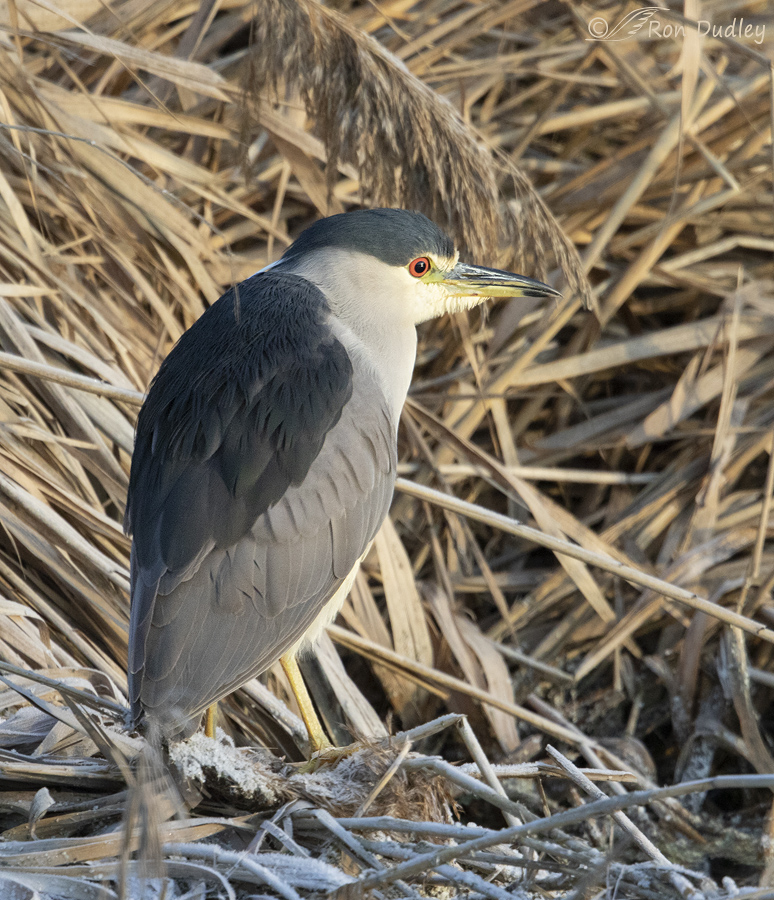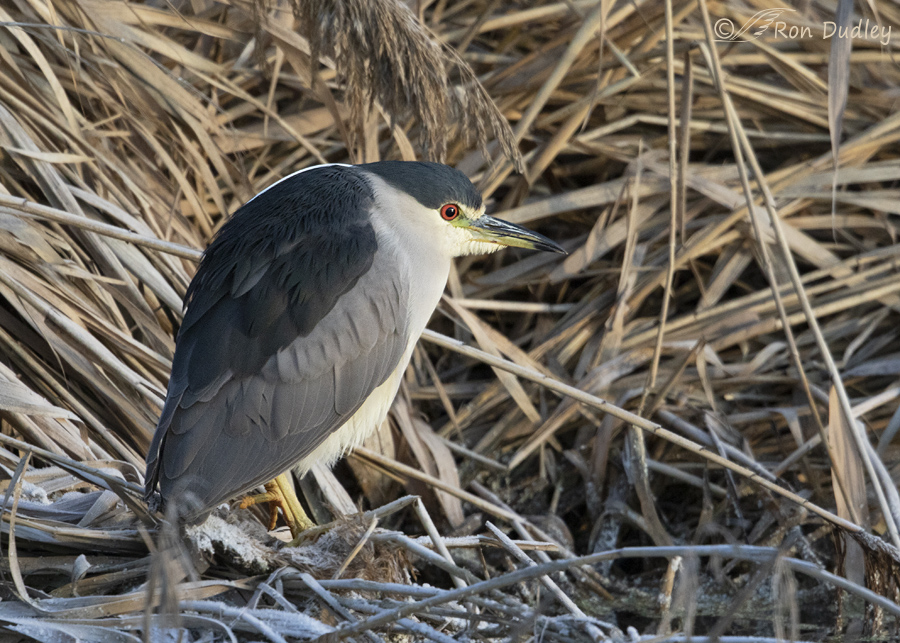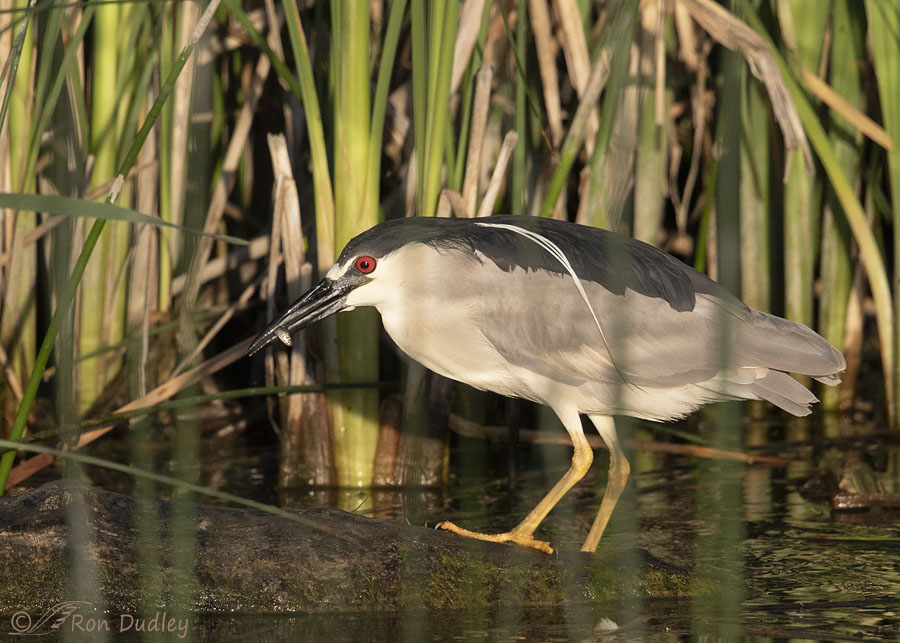The Farmington Curse strikes again but yesterday morning there was compensation.
Farmington (both the town and the refuge) sits in a jog in the Wasatch Mountains that traps clouds. The result is a phenomenon I began to call the “Farmington Curse” over a decade ago where all of northern Utah is sunny, especially in the early morning, except for Farmington. That unfortunate phenomenon occurred once again yesterday morning, I could see bright blue skies in all directions except overhead and extending to the east where the sun was (theoretically) coming up over the mountains.

1/1250, f/6.3, ISO 1600, Canon 7D Mark II, Canon EF 500mm f/4L IS II USM + EF 1.4 III Extender, not baited, set up or called in
But I did have a bit of luck for a few moments when the sun peeked through the edge of the clouds just above the mountains to provide some nice warm light on this adult Black-crowned Night Heron. The light didn’t last long but it was long enough for a few fairly nice photos. I’m growing weary of all the dead phrags in the background of so many of my photos lately so I’ve cropped fairly tightly on these shots in an effort to minimize them.
Blog follower Shane Smith asked the following question in a comment on yesterday’s post about the feather groups of a Great Blue Heron:
- “In your photo I notice a little feather from the back of the head. Is this standard with herons?”
I explained to Shane that the feather he’d noticed was one of the occipital plumes which are long ornamental feathers that develop on the hind crown of some heron species, including Great Blues. The plumes are shorter in immature herons and absent in juveniles.
Well, Black-crowned Night Herons have them too. In this photo we can see just a small portion of the occipital plume, the white strand falling down from the back of the head and disappearing behind the scapulars.

1/1600, f/6.3, ISO 1600, Canon 7D Mark II, Canon EF 500mm f/4L IS II USM + EF 1.4 III Extender, not baited, set up or called in
But in another photo of the same bird we can see much more of the brilliant white occipital plume. Its whites are so intensely bright in direct light that they can be an exposure problem for bird photographers.
Here’s an even better look at the occipital plumes of an adult Black-crowned Night Heron. This photo was taken last summer at Bear River MBR. The process of snagging this tiny fish tossed the plumes down the side of the heron where they’re much easier to see.
After photographing the night heron the sun all but disappeared so on an impulse I stopped at the nearby Eccles Wildlife Center to see if I could catch up on recent “goings on” at Farmington with manager Billy Fenimore. I always enjoy visiting with Billy – his pleasant, easy-going manner soothes my sometimes troubled soul and I love his passion for the largely educational mission of the Wildlife Center.
That stop at the center turned out to be a fortunate “three-fer” for me. Farmington Bay WMA manager Jason Jones stopped in for a cup of coffee so we all shot the breeze for a while and it so happened that HawkWatch International was holding an organizational meeting in the Wildlife Center Auditorium so I was able to visit with Nikki Wayment, Executive Director of HWI.
So visiting with three old friends turned out to be a welcome salve for the Farmington Curse. And wouldn’t you know it, just about the time we had to head for home the Farmington Curse vanished and sunny skies returned.
Typical Ron Dudley timing.
Ron
Note: Yet another plus that comes from visiting with Nikki is the chance to catch up on the status of Galileo, the Short-eared Owl that Mia and I rescued off of barbed wire several years ago and who now serves as an education bird for HWI. Nikki told me that despite the fact that Galileo can be a little turd at times he’s doing very well overall. Everyone at HWI loves him, including friend and blog follower Tana Peery Hunter who is one of his primary caretakers.
In my view Galileo has had enough drama in his short life that he’s earned the right to be a little turd whenever he feels like it.



I like the plumes as well as their red 3-D eyes that almost sit outside the eye socket.
Their eyes do seem to bulge, don’t they Jane.
Nicely representative of the Black-crowned Night Heron. As Kathy noted, “…just sort of slouched down a bit, a far off forlorn look in his eye…”, indeed, as that is their customary attitude. At least it is for the band of slouchers out my way. But they certainly are endearing in their own slouchy coy way.
79F here in Sonoma County today, clear blue skies and no rain for weeks. Very nice to have clear sky but a longer stretch than normal for sure.
Thanks, Dave. Customary attitude indeed.
Beautiful photos. I’m glad you were able to catch up with some friends. Sounds like a wonderful visit. Thumbs up for Galileo. I’m just glad he is alive and kicking.
Me too, Jean. Galileo had a very, very close call. Thank you.
Looks and sounds like you had a great day despite the fickle sun. A group of us will be going up to Reifel Bird Sanctuary just above the border in British Columbia tomorrow where they have “often the only flock of this species found in mid-winter across Canada.” I’ll be sure to look for the mandible coloring. Thanks for the timely photos and tips on aging (the Herons, that is)
And thanks to Kris for noticing.
Good luck with them tomorrow, Lyle!
Turd bird rights. Galileo has them. I really love this heron. What a pretty bird!
I really love this heron. What a pretty bird!
Yup, he has them in spades, Arwen.
Add me to those cursed with insomnia this morning. Pain is a rotten way to wake. Despite faffing round with the PC for three quarters of an hour (and changing monitors) it is just after 4 now.
And, as I so often am, I am grateful for the heart balm for your photos provide.
Of course Gallileo has earned the right to be a little turd. If he didn’t have that right he would take it anyway.
Thanks, EC. Insomnia is a pain in the butt. I’m hoping I can salvage some of my day with an afternoon nap.
What an elegantly beautiful bird ! Its neutral coloring really points up the brilliant red-orange eye color, and I noticed that in the first 2 images, the
area between the eye and the beak is a pronounced yellow-green, but in the summer shot, that area is grey. Is that an individual variation, a seasonal
one or ?
Kris, here’s what Cornell’s BNA Online has to say on the subject:
“Upper mandible light drab with grayish tip at hatching, becoming yellowish at 5–10 d, black with yellowish sides basally at 50 d, and black with greenish olive sides basally at 1 yr. It varies from grayish to blackish in second year and thereafter becomes entirely black during breeding season but regains olive green base when birds are not breeding.’
Beautiful bird, Ron and the commentary on the occipital plume. The night herons are a bit of a strange bird. Imagine they do struggle in the habitat they are given….
The night herons are a bit of a strange bird. Imagine they do struggle in the habitat they are given….  Glad the day was “saved” with a visit with old friends and and update on Galileo even if the sun did a na,nana,na na when you were leaving.. Doing the wind and an Alberta Clipper coming later in the day. Little snow but amazing what the wind can do with it!
Glad the day was “saved” with a visit with old friends and and update on Galileo even if the sun did a na,nana,na na when you were leaving.. Doing the wind and an Alberta Clipper coming later in the day. Little snow but amazing what the wind can do with it!
I agree, they are a little strange, Judy. Gotta love’m though.
Oh …your photos are making me quite anxious to get out and photograph again. Conditions here have been about as bad as yours with the lighting and now 6″ of fresh white stuff on Sunday! For some strange reason these first two photos really call out to me. He’s just sort of slouched down a bit, a far off forlorn look in his eye, slightly raising one foot in the second photo…’Darn it’s cold …my toes are freezing! Why am I here?’ Seeing the frost on the ‘phrag’ pieces around his feet I feel for him. Nice catch.
Thank you, Kathy. We’ve had colder mornings than yesterday but it was plenty cold enough. At least the wind wasn’t blowing like it was the day before at Bear River. Now that was COLD!
Could not sleep, so here I am with my first cup of coffee checking in with Feathered Photography at 5:38 am. Beautiful shots of the Night Heron Ron. One of my favorites although we don’t get to see them often here. Looks like you got some sun just at the perfect time to light up its face and catch its colors. And that one photo gives us an excellent look at the occipital plume. And very nice too that you were able to visit with some of your friends at the wildlife center there.
I had trouble sleeping too, Everett. I won’t even mention what time I got up. It’s crazy…
Around here we have this species all winter but they often struggle in the cold, especially the juveniles. I photographed a juvie yesterday morning and “he” looked like he might be having a tough time. Hope not.